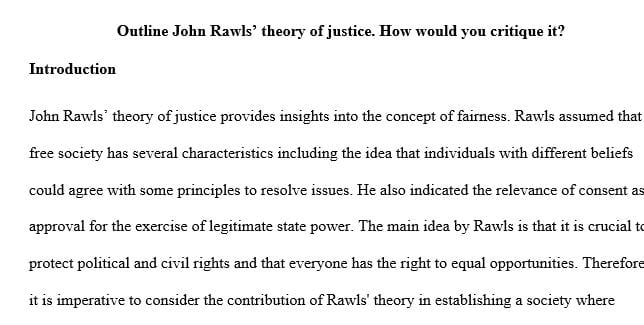Outline John Rawls’ theory of justice. How would you critique it
PHL 212- Intro to Ethics Paper 1- Chapters 1-8
PAPER 1- Pick from ONE of the questions below and answer in essay form.
TO GET PROPER CREDIT YOU MUST:
Name your file: Paper One Last Name, i.e. Paper One Jones
Put your name on the actual document you are submitting.
Write out and answer the question. Check all spelling and grammar in MLA format. Double-space.
Cite all sources, direct quotes or indirect ideas using elliptic giving author AND page numbers, i.e. (Thiroux, 26). Failure here could result in a 0%!
Include a Works Cited page at the end. Must incorporate at least three sources and at least three philosophers to substantiate your points. Must use academic sources.
Make sure you submit the work in Turn It Inin a single Word document in doc. or docx. or richtext format.
7. Your essay is to be between 1200-1600 words. Extensive quotes (more than 20%) do not count toward this. If you cannot answer a question in these parameters, use another question. Minimum word count DOES NOT insure an excellent grade. Questions and Works Cited do not count towards the word count. You may not use Wikipedia as a source, nor recycle a previous paper from another class.
CHAPTER 1 – THE NATURE OF MORALITY
- What is the relation between philosophy and morality?
- What is morality?
- What are the different approaches to morality?
- How does morality differ from aesthetics, etiquette, law, religion, or custom?
- Where does morality come from?
- Why should you be moral?
CHAPTER 2 – CONSEQUENTIALIST (TELEOLOGICAL) THEORIES OF MORALITY
- What is egoism? Explain the differences between the various “egoisms.” Are you an egoist?
- What is act utilitarianism? Analyze its strengths and weaknesses. Is it a good theory?
- What is rule utilitarianism? Analyze its strengths and weaknesses. Is it a good theory?
- What is “care ethics”? Can justice and care be integrated?
- What are the strengths and weaknesses of consequentialism generally?
CHAPTER 3 – NONCONSEQUENTIALIST (DEONTOLOGICAL) THEORIES OF MORALITY
- Are you an act nonconsequentialist? Explain why or why not.
- Analyze one of the rule nonconsequentialist theories. Do the strengths outweigh the weaknesses?
- Describe the differences between act and rule nonconsequentialism.
- Compare consequentialist and nonconsequentialist approaches to morality. Which do you think is best overall and why?
CHAPTER 4 – VIRTUE ETHICS
- How are the virtue ethics of Aristotle and Confucius similar? Distinct?
- What are the advantages and disadvantages of Aristotelian virtue ethics? Compare with its modern equivalents.
- Compare virtue ethics to both consequentialist and nonconsequentialist approaches. Of the three, which is the best and why?
- How does the notion of “self-cultivation” lead to influence of society more broadly?
CHAPTER 5 – ABSOLUTISM VERSUS RELATIVISM
- What are the problems associated with absolute conceptions of morality? Do the “facts” suggest that these problems could be overcome?
- Are you a relativist? Explain why or why not, making sure that you look at arguments for and against.
- What is the Emotive theory? Explain the advantages and disadvantages of holding such a view.
- Analyze Moore’s naturalistic fallacy. Is Moore right?
- Is morality absolute or relative? Give examples and justify your view.
CHAPTER 6 – FREEDOM VERSUS DETERMINISM
- Did you use free will in answering this question? Critically examine the arguments for and against.
- Does everything have a cause? In your answer deal thoroughly with the question of moral responsibility.
- If God is all knowing there cannot be free will. Discuss.
- Compatibilism or soft determinism is the view that free will and determinism are compatible.
Analyze the strengths and weaknesses of this view.
- Which position is the best here and on what grounds?
CHAPTER 7 – REWARD AND PUNISHMENT
- Analyze the two main theories of how to reward. Which is the best, and why?
- What are the strengths and weaknesses of the utilitarian theories of punishment?
- Retributivism justifies punishment on the basis of desert. What are the advantages and disadvantages of this approach?
- Is restitution a plausible way of punishing? Explain any difficulties with this view and advantages.
- Is a synthesis of these theories possible? Discuss with reference to all of the models introduced in this chapter.
- Outline John Rawls’ theory of justice. How would you critique it?
CHAPTER 8 – SETTING UP A MORAL SYSTEM: BASIC ASSUMPTIONS AND BASIC PRINCIPLES
- Pick out one unresolved problem from our list and attempt to push through to a conclusion, clarifying as many smaller parts as you can.
- State and defend five basic principles that would form the basis of your own ethical system, paying attention to strengths as well as potential weaknesses.
- Critically evaluate the author’s stated principles and their priorities. Which ones would you replace and why?
- Choose a moral issue and apply your own moral principles to it, dealing with inconsistencies and/or problems that arise.
- How does your moral framework repeat, conflict with, or depart from the moral system that you came into class with? Explore the differences and explain what you’ve learned. You should ask this question again at the end of the course.
Solution preview for the order on outline John Rawls’ theory of justice. How would you critique it

APA
1250 words
